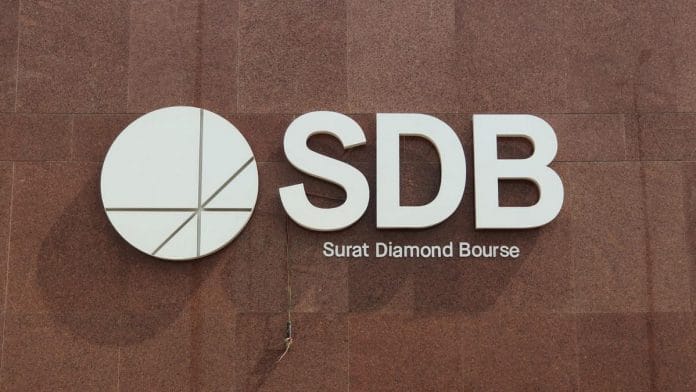Mumbai/Surat: Until late last month, the pecking order among India’s so-called ‘diamond cities’ was crystal clear. Surat was responsible for most of the cutting and polishing of rough stones in its multitude of workshops, while Mumbai was in charge of distributing and exporting the valuable merchandise. However, now, Mumbai thinks Surat is getting a bit too big for its boots. Not only is the Gujarat city in the process of opening a lavish new diamond bourse (exchange), it is also reportedly trying to incentivise diamond traders to move away from Mumbai.
The Surat Diamond Bourse (SDB), which is currently under construction, is expected to open in three or four months. Spread out over 66 lakh square feet of built-up space and flush with investments to the tune of Rs 3,000 crore, this glitzy “diamond city” will comprise nine 16-floor towers that are expected to house nearly 4,400 merchants and employ about 1.5 lakh people. It will also have its own customs clearance house.

For the inauguration, the SDB committee is already making tentative plans to invite not just Prime Minister Narendra Modi, but also Russian President Vladimir Putin, according to Dinesh Navadiya, Surat regional head, Gems and Jewellery Export Promotion Council (GJEPC) and SDB committee member.
However, what has raised hackles in Mumbai is a circular that the Surat Diamond Bourse sent out last month to its members. The document stated that those who shifted their business from Mumbai and sold their cut and polished diamonds from Surat would get to feature in a “leading members” list that would grace a huge display in the reception area. Not just that, the circular promised that early birds who started polished diamond trading from SDB in the first phase would be provided with 100 per cent exemption from the payment of monthly maintenance for six months.
The Bharat Diamond Bourse in Mumbai, therefore, has reason to fear that Surat has every intention of taking away its glitter, and there have been reports of Mumbai diamond industry leaders finding the circular “objectionable”.
Surat, meanwhile, says it is just trying to boost business. “There is a positive reaction… many people are ready. But only when it starts, we will get to know about it how many have shifted,” Navadiya told ThePrint. “The circular doesn’t force people to shut down business in Mumbai. This could be a misunderstanding. This is an attraction scheme to boost our business. And whenever there is a big market involved, it can survive in two places,” he said.
ThePrint tried to reach GJEPC chairman Colin Shah, who has an office in Bharat Diamond Bourse, but there was no response till this report was published. ThePrint also spoke to several diamantaires, some of whom said they were willing to switch to Surat, but others who complained that the way the SDB was conducting itself was “not right”.
Also Read: Planned as the next Singapore in 2012, Gujarat’s Gift city still remains a work in progress
A tempting offer for some
Manoharbhai Sanspara, whose company Sahil Star has offices in Mumbai, Surat, as well as abroad, said he is contemplating shifting most of his business to Surat because it is a “low-cost city”. He is already based in Surat and currently commutes twice a week to Mumbai.
“Expenses are low… and here in Surat, the offices are given at no-cost-no-profit, so the rent is not more than Rs 60-70 per square foot. And the lifestyle is very cheap here,” he told ThePrint, adding that he hopes his brother, a diamond trader in Mumbai, also shifts to Surat soon.
According to Sanspara, Surat has several other things going for it: Good connectivity, less traffic, an upcoming metro, and the chance to maintain a more financially sustainable lifestyle. “People will transfer here because cost is low and lifestyle is high,” he said.
However, he said that a complete transfer would be a tall ask, and that both bourses would continue to function. “Now even a bullet train will be introduced, which will further bring these two cities together,” he said.
Damjibhai Mavani, secretary of Surat Diamond Association, claimed that shifting to his city would bring down merchants’ expenses by a fifth.
“If even the raw material suppliers open up their offices here, it will save a lot of cost to merchants who otherwise have to go to Dubai, Belgium to get raw materials,” Mavani said.
But, not everyone is convinced.
‘This is not proper’
Sanjay Kothari, who has a diamond business in Mumbai, said both bourses could co-exist, and gave the examples of Israel and New York.
He also disapproved of the Surat Diamond Bourse’s incentives. “This is not proper. Whoever is comfortable wherever, they can go there. And the incentive of six months’ maintenance free is also not right as well,” Kothari said.
“This will impact Mumbai business a bit but we will see how it goes. Some will go [to Surat] and some won’t. The diamond business is huge so both places will survive,” he said.
Kumar Jain, who owns a diamond shop in Mumbai, said he had no plans of shifting base. “Why would I shift there when I have over years toiled in Mumbai and cultivated my customers?” he asked.
Mumbai and Surat: Upsetting an old equation
Mumbai and Surat are both diamond hubs, but have traditionally performed distinct functions in the industry.
Rough diamonds from the mines of Africa, Russia, and Belgium make their way to Surat, where they are cut and polished. According to the GJEPC, Surat cuts and polishes 90 per cent of world’s diamonds, and has been a leader on this front since the 1960s.

However, once the diamonds are polished, they are sent to Mumbai, from where they are transported to different parts of the country and exported.
This system of sending diamonds to Mumbai merchants started in the 1970s, but the Bharat Diamond Bourse (BDB) was set up only in 2010. Spanning 20 lakh sq ft, the BDB has nine towers that house 2,500 offices. It handles about 98 per cent of India’s diamond exports.
According to the GJEPC, during April-December 2021, cut and polished diamonds grew to $18 billion in exports.
“Historically, Surat was doing all the production while all corporate offices were in Mumbai,” Mavani said. But with old equations changing in more ways than one, the usually tranquil relations between Maharashtra and Gujarat have been wobbly of late.
Since the announcement of the Gujarat International Finance Tec-City (GIFT), touted to eventually become a Singapore-style business district, the political class in Maharashtra have accused the central government of trying to snatch away businesses from Mumbai and shift them to Gujarat.
The Maharashtra government is also miffed over the Centre not giving a special economic zone (SEZ) clearance to the International Financial Services Centre (IFSC) in Mumbai, alleging that this was driven by a desire to give the upper hand to GIFT city in Gujarat.
In this context, the new diamond bourse in Surat has riled traders in Mumbai who feel that emphasis should be given on coexistence rather than on giving weightage to only one bourse.
(Edited by Asavari Singh)
Also Read: Why Coimbatore, Indore & Surat will decide success of India’s urbanisation. Not Mumbai & Delhi






